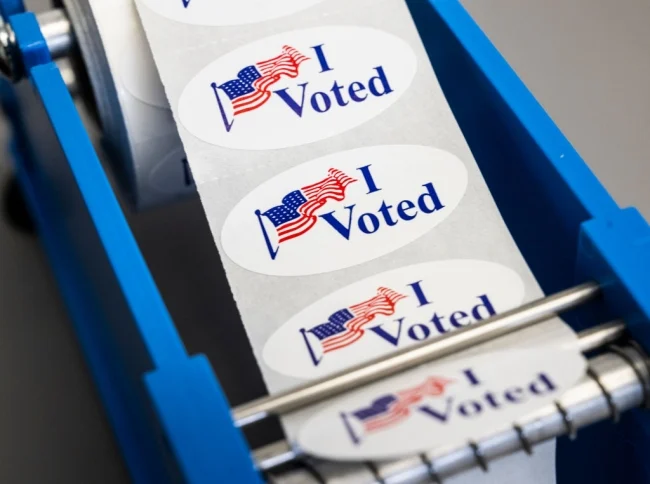By Ashley Mowreader
A September survey of 1,012 students found, across most groups, the economy/cost of living is the most important issue in determining whom or what students will vote for in the upcoming election, with 52 percent of respondents selecting that.
Similarly important issues, among 12 listed in the survey, conducted by Inside Higher Ed and Generation Lab, are reproductive rights (45 percent), the future of democracy (26 percent), gun violence/control (23 percent) and immigration (22 percent).
The findings emphasize that the issues important to young voters in general ring true with many enrolled in higher education, as well as how institution type and demographic factors can influence trends among college students.
One in five voters prioritize environmental issues (20 percent), while fewer respondents rank racial justice and civil rights (18 percent), crime and safety (17 percent), or LGBTQIA+ issues (17 percent) as key issues.
Compared to their peers, Black students rank racial justice and civil rights issues higher (41 percent, or third over all), and Hispanic students identify gun violence/control (31 percent, or third over all) as more important.
As a professor at a historically Black college, Monroe isn’t shocked to see Black students’ top issues, and that students across campus express similar sentiments. He is surprised, however, by how reproductive rights rank across learners.
Female students indicate a high level of concern regarding reproductive rights (59 percent) compared to their male counterparts (22 percent), as do nonbinary students (64 percent).
Only 11 percent of students indicate the Israel-Hamas war is a top priority for them, but seven additional students allude to Palestine and Gaza in “other” responses, and five students include foreign affairs and international policy as another concern.
Breanna Denaye McRoberts, a junior at Prairie View A&M, thinks the survey results are less representative of how students feel about the conflict in Gaza. “Most of my peer group agree that what is happening in Gaza is cruel and has gone on too long. If anything, I have noticed that it is a deal breaker for some students to decide who they vote for.”
Monroe hypothesizes students might rank foreign policy issues higher if there was more direct U.S. involvement; both conflicts, between Ukraine and Russia and Israel and Hamas, can feel distant for the average college student unless they have an ethnic or personalized tie to the events.
Private school students are more likely to rank social issues as important, including the future of democracy (36 percent), environmental issues (26 percent) and the Israel-Hamas war (19 percent), compared to public school students, of whom 23 percent consider the future of democracy a top issue, 18 percent environmental issues and only 9 percent Israel-Hamas.
The breakdown between private and public college students highlights how those who “have and have not,” consider issues differently, Monroe says. “Private school students look at the world differently and they look at college differently” because they are more economically secure.
“The future of democracy, to me, means protecting the rights of all citizens in this country,” McRoberts says. “The future of democracy is something that worries me. We are a diverse country, meaning everyone has different needs, and even if I may not need a service or safety net, it should still be available to those who do.”
Student loan debt/reform was a top priority to 13 percent of respondents, but more important to adult learners (18 percent), Black students (16 percent) and public school students (15 percent).
Among total respondents, 8 percent select more funding for higher ed as a major issue they care about; Hispanic learners (12 percent) community college students (11 percent) are more likely to rank this as a top priority.
Around 3 percent of respondents say none of the listed issues are important to them or that they don’t care about politics.
A national picture: The Spring 2024 Harvard Youth Poll, conducted by the Harvard Public Opinion Project, found a majority of young adults (classified as ages 18 to 29) in the U.S., similarly, identify inflation (64 percent) as a top concern, as well as health care (59 percent), housing (56 percent), gun violence (54 percent) and jobs (53 percent).
A May GenForward survey by the University of Chicago found young people believe economic growth, income inequality and the national debt, were the most important problems facing the U.S. today. In their communities, young people rank income inequality and economic growth as top issues, as well as poverty, high taxes and homelessness.
More recent data from the National Society of High School Scholars, which polls high schoolers and recent graduates, found the economy, health care, women’s rights and the environment are important to younger voters.
So what? College students, as a population, are increasingly diverse and represent a variety of backgrounds and lived experiences. To elected officials, they continue to be filtered into two categories: college versus no college or the 18- to 25-year-old population, Monroe says.
“What I tell my students all the time, if the 18- to 25-year-old population voted in ways that are expected of those 65 and older, the government would be much more responsive to their desires,” Monroe says, referring to policy priorities among elected officials.
The most important thing is for students to be well informed and do their own research to truly know why they’re voting and whom they’re voting for, Monroe adds.

